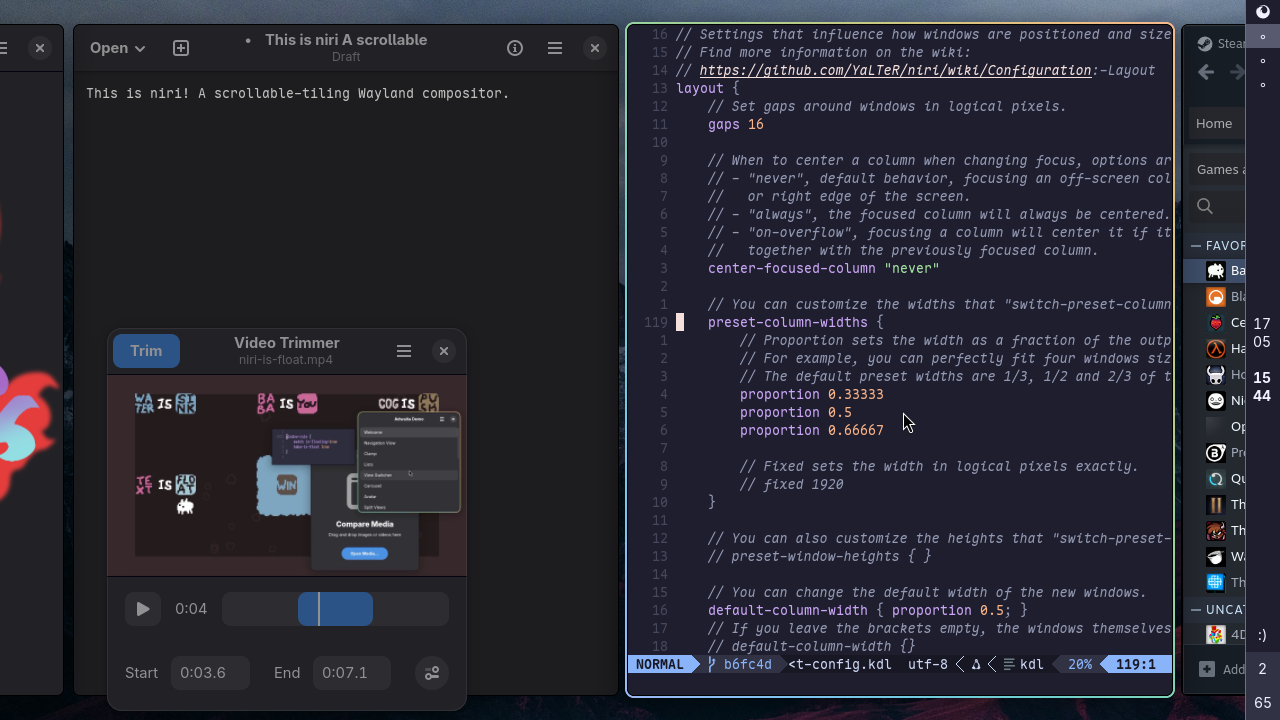I discovered niri this morning the way you discover most things these days: through a rabbit hole that started with someone’s rice post and ended with me questioning my life choices. For the uninitiated, niri is a scrollable-tiling Wayland compositor that lets you navigate your windows by scrolling horizontally through columns instead of jumping between discrete workspaces. It’s either brilliant or completely pointless, and I can’t decide which.

The concept is neat enough: your desktop becomes an infinite horizontal canvas where windows live in columns, and you scroll left and right to find what you need. It’s spatial navigation for people who think in terms of “over there” rather than “workspace 3.” But as someone who’s spent years perfecting a master/stack automatic workflow where new windows spawn predictably in the top-right corner, pushing older windows down while leaving my master window untouched, niri feels like being asked to swap a well-organized bookshelf for a never-ending hallway of scattered books.
This brings up a larger issue with Wayland tiling: the options are still frustratingly limited if you’re particular about your workflow. We’ve got Sway (i3 but Wayland), Hyprland (Sway but with automatic tiling), and a handful of experimental compositors that may or may not work with your monitor setup. Coming from qtile’s Python configurability, the landscape feels both promising and constrained.
Hyprland deserves credit here – it’s probably the first Wayland compositor that implements 99% of what makes a really good tiler. The window management is solid, the animations don’t make you want to disable them immediately, and the configuration is comprehensive enough that you can usually bend it to your will. It’s good software that mostly gets out of your way, which is high praise in the world of window managers.
But here’s where things get nostalgic in the most pathetic way possible: Hyprland represents this awkward transition from X11’s mature, elegant tooling to Wayland’s “we’ll build it as we go” philosophy. Take sxhkd, that perfect piece of software that let you define keybindings with ranges and conditionals in syntax so clean it felt like poetry:
super + {1-9,0}
bspc desktop -f '^{1-9,10}'
super + shift + {h,j,k,l}
bspc node -m {west,south,north,east}
Beautiful, expressive, concise. Hyprland’s submaps work, but they’re verbose in the way that makes you miss what you had:
bind = $mainMod, A, submap, applications submap = applications bind = , t,
exec, alacritty
bind = , f, exec, firefox bind = , escape, submap, reset submap
= reset
I’ve developed a workaround system using thematic namespaces (meta+a for applications, meta+i for info scripts, meta+r for rofi modes) that’s actually more organized than my old sxhkd setup. I even added a clever “unused shortcut” notification fallback – press an undefined key in a submap and get a notification telling you it’s available. It’s the kind of user experience polish you end up implementing yourself because the tools aren’t quite there yet.
Then there’s tdrop, another X11 gem that made dropdown terminals trivial. One
command: tdrop -ma -w 50% -h 40% -x 25% -y 5% alacritty and you had a
perfectly centered floating terminal that toggled on demand. In Hyprland, you
achieve the same thing through a combination of workspace rules, window rules,
keybindings, and animation configurations. It works, but it’s the difference
between using a specialized tool and assembling a solution from general-purpose
parts.
This isn’t really a complaint – it’s more like watching a new ecosystem grow in real time. The X11 world had decades to develop focused, single-purpose tools that did one thing beautifully. Wayland compositors are powerful and modern, but that modernity often comes with complexity that makes simple things harder than they should be.
Will I try niri? Probably. Am I skeptical that scrolling through infinite columns will feel better than my predictable master/stack layout? Absolutely. But there’s something appealing about the spatial approach, even if it’s probably a solution looking for a problem.
The real question isn’t whether niri is a gimmick – it’s whether we’re willing to trade the elegant simplicity of mature tools for the promise of something better, even when “better” is still under construction. Most days, I’m happy with that trade-off. Some days, I miss sxhkd more than I care to admit.